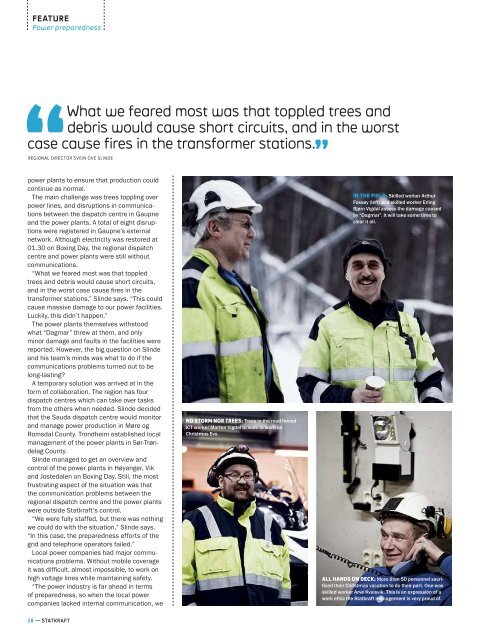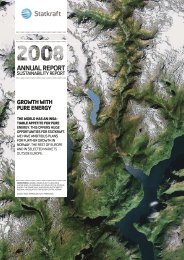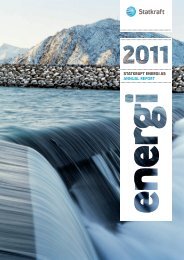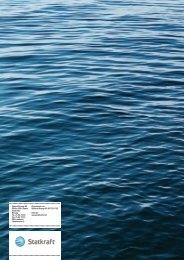CoNqueRed the StoRM - Statkraft
CoNqueRed the StoRM - Statkraft
CoNqueRed the StoRM - Statkraft
You also want an ePaper? Increase the reach of your titles
YUMPU automatically turns print PDFs into web optimized ePapers that Google loves.
feature<br />
Powerpreparedness<br />
what we feared most was that toppled trees and<br />
debris would cause short circuits, and in <strong>the</strong> worst<br />
case cause fires in <strong>the</strong> transformer stations.<br />
RegionaL diReCtoR svein ove sLinde<br />
thiS iS typical For our culture, and<br />
expreSSeS a mindSet we appreciate.<br />
pRoduKsjonsdiReKtøR tRon engebRethsen<br />
power plants to ensure that production could<br />
continue as normal.<br />
The main challenge was trees toppling over<br />
power lines, and disruptions in communications<br />
between <strong>the</strong> dispatch centre in Gaupne<br />
and <strong>the</strong> power plants. A total of eight disruptions<br />
were registered in Gaupne’s external<br />
network. Although electricity was restored at<br />
01.30 on Boxing Day, <strong>the</strong> regional dispatch<br />
centre and power plants were still without<br />
communications.<br />
“What we feared most was that toppled<br />
trees and debris would cause short circuits,<br />
and in <strong>the</strong> worst case cause fires in <strong>the</strong><br />
transformer stations,” Slinde says. “This could<br />
cause massive damage to our power facilities.<br />
Luckily, this didn’t happen.”<br />
The power plants <strong>the</strong>mselves withstood<br />
what “Dagmar” threw at <strong>the</strong>m, and only<br />
minor damage and faults in <strong>the</strong> facilities were<br />
reported. However, <strong>the</strong> big question on Slinde<br />
and his team’s minds was what to do if <strong>the</strong><br />
communications problems turned out to be<br />
long-lasting?<br />
A temporary solution was arrived at in <strong>the</strong><br />
form of collaboration. The region has four<br />
dispatch centres which can take over tasks<br />
from <strong>the</strong> o<strong>the</strong>rs when needed. Slinde decided<br />
that <strong>the</strong> Sauda dispatch centre would monitor<br />
and manage power production in Møre og<br />
Romsdal County. Trondheim established local<br />
management of <strong>the</strong> power plants in Sør-Trøndelag<br />
County.<br />
Slinde managed to get an overview and<br />
control of <strong>the</strong> power plants in Høyanger, Vik<br />
and Jostedalen on Boxing Day. Still, <strong>the</strong> most<br />
frustrating aspect of <strong>the</strong> situation was that<br />
<strong>the</strong> communication problems between <strong>the</strong><br />
regional dispatch centre and <strong>the</strong> power plants<br />
were outside <strong>Statkraft</strong>’s control.<br />
“We were fully staffed, but <strong>the</strong>re was nothing<br />
we could do with <strong>the</strong> situation,” Slinde says.<br />
“In this case, <strong>the</strong> preparedness efforts of <strong>the</strong><br />
grid and telephone operators failed.”<br />
Local power companies had major communications<br />
problems. Without mobile coverage<br />
it was difficult, almost impossible, to work on<br />
high voltage lines while maintaining safety.<br />
“The power industry is far ahead in terms<br />
of preparedness, so when <strong>the</strong> local power<br />
companies lacked internal communication, we<br />
no storm nor trees: Trees in <strong>the</strong> road forced<br />
ICT worker Morten Vigdal to walk to work on<br />
Christmas Eve.<br />
in <strong>the</strong> field: Skilled worker Arthur<br />
Fossøy (left) and skilled worker Erling<br />
Bjørn Vigdal assess <strong>the</strong> damage caused<br />
by “dagmar”. It will take some time to<br />
clear it all.<br />
all hands on deck: More than 50 personnel sacrificed<br />
<strong>the</strong>ir Christmas vacation to do <strong>the</strong>ir part. One was<br />
skilled worker Arve Kvalsvik. This is an expression of a<br />
work ethic <strong>the</strong> <strong>Statkraft</strong> management is very proud of.<br />
had both satellite phones and walkie-talkies<br />
<strong>the</strong>y could borrow," Vigdal says. “I think this<br />
was essential in resolving <strong>the</strong> situation as<br />
quickly as it did.”<br />
one outsideline<br />
During <strong>the</strong>se hectic Christmas days, <strong>the</strong>y<br />
worked around <strong>the</strong> clock.<br />
“There was plenty to do, both big and<br />
small tasks,” Vigdal says. “One of <strong>the</strong> most<br />
important jobs was to ensure that <strong>the</strong> batteryoperated<br />
communications unit on top of <strong>the</strong><br />
mountain in Jostedalen Valley did not run out<br />
of fuel. During <strong>the</strong> day, people went to <strong>the</strong><br />
mountain top with a generator and petrol, just<br />
to make sure.”<br />
The solution came on <strong>the</strong> evening of 27<br />
December. This is when <strong>the</strong>y found a line in<br />
<strong>the</strong> network between Bergen and Gaupne that<br />
was fault free. The day after, major reconfiguration<br />
work started, and traffic was rerouted.<br />
“However, we only had one outside line – not<br />
four as we usually do – but we figured it would<br />
do,” Slinde says.<br />
And so it did. On 28 December, at 10.30<br />
hours, <strong>the</strong> relief in <strong>the</strong> Gaupne dispatch<br />
centre was palpable: People were finally able<br />
to return to <strong>the</strong>ir families and continue <strong>the</strong>ir<br />
Christmas vacation. The preparedness situation<br />
was called off.<br />
At this point, most of <strong>the</strong> employees had<br />
been working non-stop since Christmas Day.<br />
Even-André Bolstad, who is an electrical<br />
specialist, performed tasks for both <strong>Statkraft</strong><br />
and an important job for Luster Energiverk,<br />
which saw most of its grid destroyed. He<br />
almost does not want to say how many hours<br />
he spent at work.<br />
“Or else I’ll get in trouble with <strong>the</strong><br />
Norwegian Labour Inspection Authority,” he<br />
says with a smile.<br />
looking forward<br />
It is now time to assess <strong>the</strong> preparedness<br />
plans and look ahead. If <strong>the</strong> climate experts<br />
are correct, we will have more extreme<br />
wea<strong>the</strong>r in <strong>the</strong> future, more wind and more<br />
intense and heavier rain falls.<br />
But after “Dagmar”, Slinde is even more<br />
confident that <strong>Statkraft</strong> has a preparedness<br />
system able to handle extreme wea<strong>the</strong>r situations.<br />
“Dagmar” was a very good proving ground<br />
for us, and has made us very confident that<br />
our system is good enough to handle such<br />
winds,” Slinde says. “But we need to rethink<br />
our approach to network and communications.<br />
Luckily, we have several improvement<br />
processes underway in this area. During crisis<br />
situations such as “Dagmar” and major flooding,<br />
it is critical when <strong>the</strong> telephone network<br />
breaks down.”<br />
He stresses that “Dagmar” also showed <strong>the</strong><br />
importance of having <strong>the</strong> right people and sufficient<br />
local resources.<br />
“We were vulnerable until all <strong>the</strong> communications<br />
channels were operational in <strong>the</strong><br />
New Year,” says Svein Ove Slinde. “I’m proud<br />
that we have a preparedness plan that works<br />
so well, and that so many employees worked<br />
around <strong>the</strong> clock to get <strong>the</strong> system operational<br />
again.”<br />
Following “Dagmar”, <strong>Statkraft</strong> will assess<br />
both communications systems and preparedness.<br />
Tron Engebrethsen, director of PG,<br />
wants to take an in-depth look at <strong>the</strong> digital<br />
communications system.<br />
“It proved to be more vulnerable than we<br />
thought," says Engebrethsen. "Although <strong>the</strong><br />
power plants produced as <strong>the</strong>y were supposed<br />
to <strong>the</strong> entire time, and <strong>the</strong>re was no<br />
damage to our facilities, we need to analyse<br />
<strong>the</strong> situation and assess alternative communications<br />
solutions. But it is still too early to say<br />
whe<strong>the</strong>r we must make changes.”<br />
What he is 100 per cent satisfied with, is<br />
<strong>the</strong> effort of <strong>the</strong> crews in Gaupne, Trondheim<br />
and Sauda, who cut <strong>the</strong>ir Christmas vacations<br />
short to roll up <strong>the</strong>ir sleeves during <strong>the</strong> height<br />
of <strong>the</strong> storm.<br />
“This is typical for our culture, and expresses<br />
a mindset we appreciate,” he says, using an example<br />
of team sprit from when storm “Narve”<br />
ravaged Nor<strong>the</strong>rn Norway in January 2006:<br />
“We had problems with ice forming in <strong>the</strong><br />
Bardu river system, and had to send people<br />
<strong>the</strong>re to get rid of <strong>the</strong> ice plug,” Engebrethsen<br />
says. “One of <strong>the</strong> crew was supposed to baptise<br />
his grandchild <strong>the</strong> day after, but felt such<br />
a responsibility for <strong>the</strong> job that he wanted to<br />
go up <strong>the</strong>re and help. We almost had to order<br />
him to get <strong>the</strong> baptism done first.”<br />
«Safetywas<br />
not at risk»<br />
in less than one year, reservoir levels<br />
have gone from record lows to very<br />
high. in January, <strong>the</strong> reservoir levels for<br />
Norwegian power plants were at 80.3<br />
per cent, compared with 45.3 per cent<br />
at <strong>the</strong> same time last year, according to<br />
Statnett. Power Generation director tron<br />
engebrethsen stresses that <strong>the</strong> topped<br />
off reservoirs pose no risk for <strong>the</strong> safety<br />
at <strong>the</strong> power plants.<br />
“Water levels and water flow are<br />
constantly monitored, and we make<br />
daily assessments of <strong>the</strong> future water<br />
situation in all water systems," says<br />
engebrethsen. "if <strong>the</strong>re is too much<br />
water, we have a drainage plan to regulate<br />
<strong>the</strong> water level. both we and <strong>the</strong><br />
Norwegian Water Resources and energy<br />
directorate (NVe) are very focused on<br />
safety. <strong>the</strong>re are, for instance, stricter<br />
dam regulations in place, which means<br />
that although we may expect more<br />
precipitation in <strong>the</strong> future, we are sure<br />
that our dams are safe and that we know<br />
exactly how much water each dam can<br />
hold. <strong>the</strong> dams are inspected at regular<br />
intervals, and all new requirements and<br />
knowledge are taken into account. if<br />
<strong>the</strong> inspection uncovers any faults or<br />
defects, under-dimensioning or changes<br />
to <strong>the</strong> consequence classification, <strong>the</strong><br />
dams will be streng<strong>the</strong>ned. over <strong>the</strong> next<br />
decade, we will spend several billion<br />
kroner on upgrades.”<br />
“however, we can never be sure that accidents<br />
won't happen," he adds. "this is<br />
why we have made preparedness plans<br />
for everything from heavy precipitation<br />
to earthquakes. <strong>the</strong> worst case scenario<br />
could be a rock or landslide into a reservoir<br />
on top of a steep mountain side. this<br />
will create a flood wave that will cause<br />
extensive damage fur<strong>the</strong>r down <strong>the</strong> river<br />
system. it is not likely to happen, but we<br />
need to imagine every scenario possible<br />
when preparing safety plans.”<br />
“<strong>the</strong>re is a large consensus that Norwegian<br />
dams are very safe,” he stresses.<br />
28 — StAtkRAft<br />
PeoPle & PoWeR — 29
















